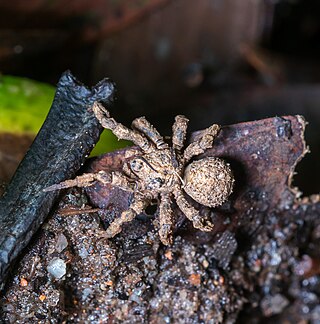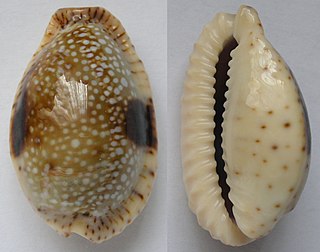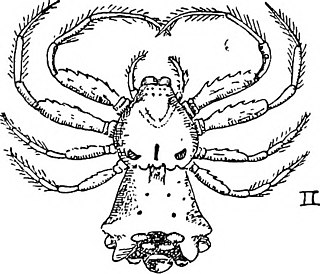
The order Embioptera, commonly known as webspinners or footspinners, are a small group of mostly tropical and subtropical insects, classified under the subclass Pterygota. The order has also been called Embiodea or Embiidina. More than 400 species in 11 families have been described, the oldest known fossils of the group being from the mid-Jurassic. Species are very similar in appearance, having long, flexible bodies, short legs, and only males having wings.

Cryptothele is a spider genus with eight described species, now placed in the family Zodariidae.
Compsomantis is a genus of praying mantids in the family Gonypetidae.

Gymnodoris ceylonica is a species of sea slug, a dorid nudibranch, a marine gastropod mollusk in the family Polyceridae.

Naria nebrites, common name the false margined cowry, is a species of sea snail, a cowry, a marine gastropod mollusk in the family Cypraeidae, the cowries.
Paratopula ceylonica is a species of ant in the subfamily Myrmicinae found in the Philippines, India, Bangladesh, Sri Lanka, and China.
Colobopsis ceylonica is a species of formicine ant. It is found from Sri Lanka.
Pheidole ceylonica is a species of ant in the subfamily Myrmicinae. It is found in Sri Lanka.

Phrynarachne is a genus of crab spiders first described by Tamerlan Thorell in 1869.
Helsdingenia is a genus of dwarf spiders that was first described by Michael I. Saaristo & A. V. Tanasevitch in 2003. The name is a reference to Dr. P. J van Helsdingen.

Phrynarachne ceylonica, the bird dung spider, is a species of spiders of the family Thomisidae. It is found in China, Japan, Sri Lanka, Taiwan, and India. The species is known to discharge a foul smell which help it attract prey and deter predators. It both smells like and resembles bird feces, hence the name 'bird dung spider'. The bird dung spider resembles bird feces only when it curls up in response to a predatory threat. It is characteristically known for its dual-purposed ability to mimic the smell and appearance of bird feces to both lure prey and protect against predators. This species of crab spider has a flat, black-brown abdomen with bright yellow legs. The width of the female abdomen is approximately 9.3 mm and the length of the body is approximately 14.5 mm.
Ceylania ceylonica is a species of beetle in the family Cerambycidae, and the type species of its genus. It was described by Stephan von Breuning in 1979. It is known from Sri Lanka.
Parasosibia ceylonica is a species of phasmid or stick insect of the genus Parasosibia. It is found in Sri Lanka.
Sipyloidea ceylonica is a species of phasmid in the genus Sipyloidea, described by Henri Louis Frédéric de Saussure in 1868 from Sri Lanka.
Oxymacaria ceylonica is a moth of the family Geometridae first described by George Hampson in 1902. It is found in Sri Lanka.
Cricula ceylonica, the Sri Lankan cricula silkmoth, is a moth of the family Saturniidae. The species was first described by Karl Jordan in 1909 and it is endemic to Sri Lanka. The debate of this species with much broader range circular species - Cricula trifenestrata is not yet fully understood. However, Rougerie et al., in 2009 considered Cricula ceylonica a valid species, probably endemic to Sri Lanka.
Aposthonia ceylonica is a species of webspinner of the family Oligotomidae native to tropical Asia, Madagascar and Mauritius. In February 2019, a colony of this insect was identified in a greenhouse at the RHS Garden, Wisley, Surrey, England, on the roots of an orchid. It was thought that the insects had been accidentally introduced on plants imported from Thailand.





